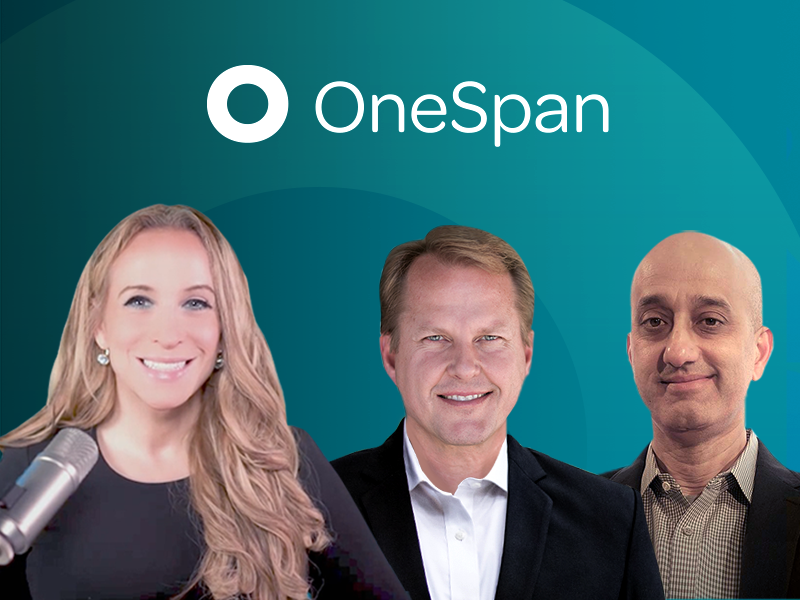OneSpan Bridges the Gap Between Online Security and Optimal Consumer Experience

Following her recent interview with OneSpan executives Sameer Hajarnis and Eric Hanson, we’re pleased to present a guest blog post from Shira Rubinoff, cybersecurity executive, author, and advisor.
I recently had the opportunity to sit down with Eric Hanson, the Chief Marketing Officer of OneSpan, and Sameer Hajarnis, the company’s VP of Growth & Transformation.
We discussed the realities of the current state we are in of Web 3.0, where we no longer have the need for centralized servers, due to the nature of where data is stored and secured over an array of devices. This decentralization of data and sensitive information has de-escalated the risk of massive data leaks and created greater security resilience. Together, we looked at the effects of this new reality on both the enterprise and consumer experiences.
Before digging in however, we took a virtual walk back through the past few years, especially around the pandemic, when businesses were quick, even hasty at times, to adopt to the remote economy that arose during Covid.
According to Eric, many businesses had to choose two of the three between “good, fast or cheap,” as the old cliché goes, and oftentimes, chose the latter two. What that meant was that in their rush to bring more products to the online market and meet consumer demand quickly, they settled for a lower bar on the security front. Since the pandemic felt like a transient phenomenon, with nobody anticipating that it would drag on for as long as it did, or that remote working, shopping, and administrating would continue to an extent, even once life returned to some semblance of normalcy, many did not give security the consideration it truly deserved, thinking that whatever they were creating would not be permanent.
The broadest attack surfaces soon became people themselves – both within organizations and among the customers they serviced. Instead of building ecommerce solutions with the appropriate levels of security built in from the ground up, organizations had to make do with band aid solutions, and brand reputations suffered, with attacks becoming more common-place, even within government, as witnessed with the multitude of PPP fraud fiascos.
OneSpan recognized that the Web 3.0 environment highlights the need to both simplify the customer experience while also securing it to restore levels of trust and loyalty that had been damaged. OneSpan also considered what Eric referred to as the “glue in between,” the security that built in at the foundation, holds everything together.
With fraud numbers increasing exponentially year after year and over $6 billion lost to fraud last year, according to the FTC, the gaps in security are undeniable. Furthermore, with the expanding adoption of Cloud computing and consumption as well as mobile adoption, Sameer characterized the current playing field as “patchwork-like” with disparate platforms and apps operating without cohesive security. It was clear that security solutions from up to five years ago and sometimes even older than that no longer functioned as effectively for the transformed and continuously transforming digital reality.
Both men described how daunting a task it is to both technically and securely deal with the internal and human factor piece while also balancing a collaborative, interpersonal model that takes into account a satisfying user experience.
What then is the solution? How can companies manage to both provide the comprehensive security that they need to both maintain and restore consumer trust and loyalty while also ensuring an effective customer experience, which in some cases may be tactile, such as in a retail clothing situation, or extremely personal, such as in the banking industry?
Eric and Sameer referred to this as a hybrid approach and gave the example of a business-customer interaction that started off in-person, as in the case of a face-to-face meeting, then incorporated online automations, for the clerk to ascertain certain information and submit an online application, rounded out by the inter-personal experience, which will be followed once more with an automated, electronic response.
This hybrid solution illustrates a scenario that affords consumers the interpersonal comfort level that many people crave, coupled with the digital security that protects their sensitive data from fraudsters.
However, they cautioned, there really is no one-size-fits-all solution for all businesses across the board, and organizations must also take into account the demographics that they serve. Older people tend to prefer the more in-person style of shopping, meeting and decision-making, while younger generations are just as comfortable in a wholly digital environment.
OneSpan takes a lot of the guessing out of the process and provides a secure and globally compliant environment for virtual interactions and collaboration, that allows businesses to verify the identity of and authenticate an individual, and gives the user the option of secure, simple, human-to-human guidance from anywhere. It is bidirectional, with consumers and businesses alike being assured that who they are speaking with is authentic, secure and verified. And, with the verified co-browsing and video capabilities embedded into the OneSpan solution, customers are able to experience the “personal touch” that they may crave from their otherwise sterile digital experience. Both Sameer and Eric were passionate about their offering and exuded excitement over the continued future of business-consumer engagement.
My main takeaway from this discussion is that the Web 3.0 reality we find ourselves in today is truly an age of both digital first and human interaction opportunities. Flexibility is key in this “Anywhere Economy”: when transactions can happen in a plethora of methods and models, it is up to businesses themselves, and they have options for the ways they choose to interact with their clients. In this climate, they must determine how to maintain their own and their customer’s security, building trust and loyalty, while also providing a personal, optimal, and repeat user experience.










